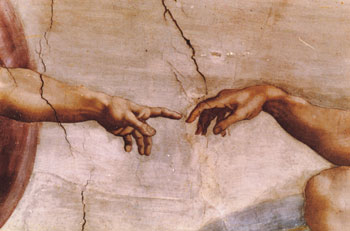Seeing and Imagining Are Different in the Brain
 The Sistine Chapel is a truly awe-inspiring sight: a testimony to human ingenuity, effort, and creativity. No less awe-inspiring — and far less easily understood — are the mental processes that allow humans to see the chapel’s famous vaulted ceilings and the paintings that adorn them. We know more or less how the Sistine Chapel was built and decorated, but scientists are still figuring out what goes on in our brains when we see it. In an article published in the Journal of Cognitive Psychology, William L. Thompson adds to our understanding of visual perception by contrasting visual attention with visual mental imagery.
The Sistine Chapel is a truly awe-inspiring sight: a testimony to human ingenuity, effort, and creativity. No less awe-inspiring — and far less easily understood — are the mental processes that allow humans to see the chapel’s famous vaulted ceilings and the paintings that adorn them. We know more or less how the Sistine Chapel was built and decorated, but scientists are still figuring out what goes on in our brains when we see it. In an article published in the Journal of Cognitive Psychology, William L. Thompson adds to our understanding of visual perception by contrasting visual attention with visual mental imagery.
Visual attention occurs when humans pinpoint certain visual information for more scrupulous analysis but discard other visual information (e.g., looking at the Michael Angelo’s The Creation of Adam on the chapel ceiling). Visual mental imagery, on the other hand, can be thought of as “seeing with the mind’s eye” (e.g., conjuring up an image of The Creation of Adam in which God is wearing sunglasses and a top hat). Thompson and his coauthors describe mental imagery as “creating, interpreting, and transforming visual mental representations.” Some scientists think that mental imagery is a result of visual attention, rather than a distinct mental process. Such scientists argue that humans visualize mental imagery by distributing visual attention to particular spaces; therefore, mental imagery is just a special type of visual attention.
Thompson’s team designed a test to determine whether visual mental imagery and visual attention really rely on the same mental processes. Their study included a visual mental imagery task and a visual attention task. Both tasks involved a manipulation in the size of the object being visualized and/or viewed. If the size manipulation affected each task differently, the researchers hypothesized, it would be possible to conclude that visual attention and visual mental imagery are actually distinct cognitive processes.
The attention task required participants to focus their attention on either a large (16.5 x 16.5 cm) or small (1.8 x 1.8 cm) square and then determine whether or not a black dot appeared within the box during a 4 s interval. The black dot, which appeared for 20 ms in half of the trials, measured 1 x 1 mm.
Like the attention task, the mental imagery task required participants to focus their attention on the large or small squares. Before determining whether a 1 x 1 mm dot appeared within the squares, however, the participants in the imagery condition were asked to visualize an assigned object (such as an elephant or the Apple logo) inside of the squares. Then, while continuing to visualize the assigned object, they completed the dot task. Next, participants were asked to indicate whether or not the object they were visualizing had a specific characteristic (e.g., “hanging ears” or “bitten left side”). The same participants completed both the mental attention and mental imagery tasks.
The participants were better at the attention task when they were dealing with the smaller square; they were better at the imagery task when they were dealing with the larger square. The fact that the size manipulation led to different results in the attention task and imagery task led Thompson and his coauthors to conclude that visual mental imagery is more than a special type of visual attention; attention and imagery are distinct cognitive processes. For scientists who study vision, it’s another small step toward understanding the human brain as well as we understand the Sistine Chapel.
![]() Thompson, W. L., Hsiao, Y., & Kosslyn, S. M. (2011). Dissociation between visual attention and visual mental imagery Journal of Cognitive Psychology, 23 (2), 256-263 : 10.1080/20445911.2011.477810
Thompson, W. L., Hsiao, Y., & Kosslyn, S. M. (2011). Dissociation between visual attention and visual mental imagery Journal of Cognitive Psychology, 23 (2), 256-263 : 10.1080/20445911.2011.477810





Comments
Did you deliberately flip the image? You have it the wrong way round, God is on the right. Interestingly if you look at the full image you will see God sitting in what looks very much like a cross section of a human brain.
((I had first noticed the different expressions of the hands & wondered about the one on the right and on the left.)) Yes the image was flipped. Excellent observations.
APS regularly opens certain online articles for discussion on our website. Effective February 2021, you must be a logged-in APS member to post comments. By posting a comment, you agree to our Community Guidelines and the display of your profile information, including your name and affiliation. Any opinions, findings, conclusions, or recommendations present in article comments are those of the writers and do not necessarily reflect the views of APS or the article’s author. For more information, please see our Community Guidelines.
Please login with your APS account to comment.